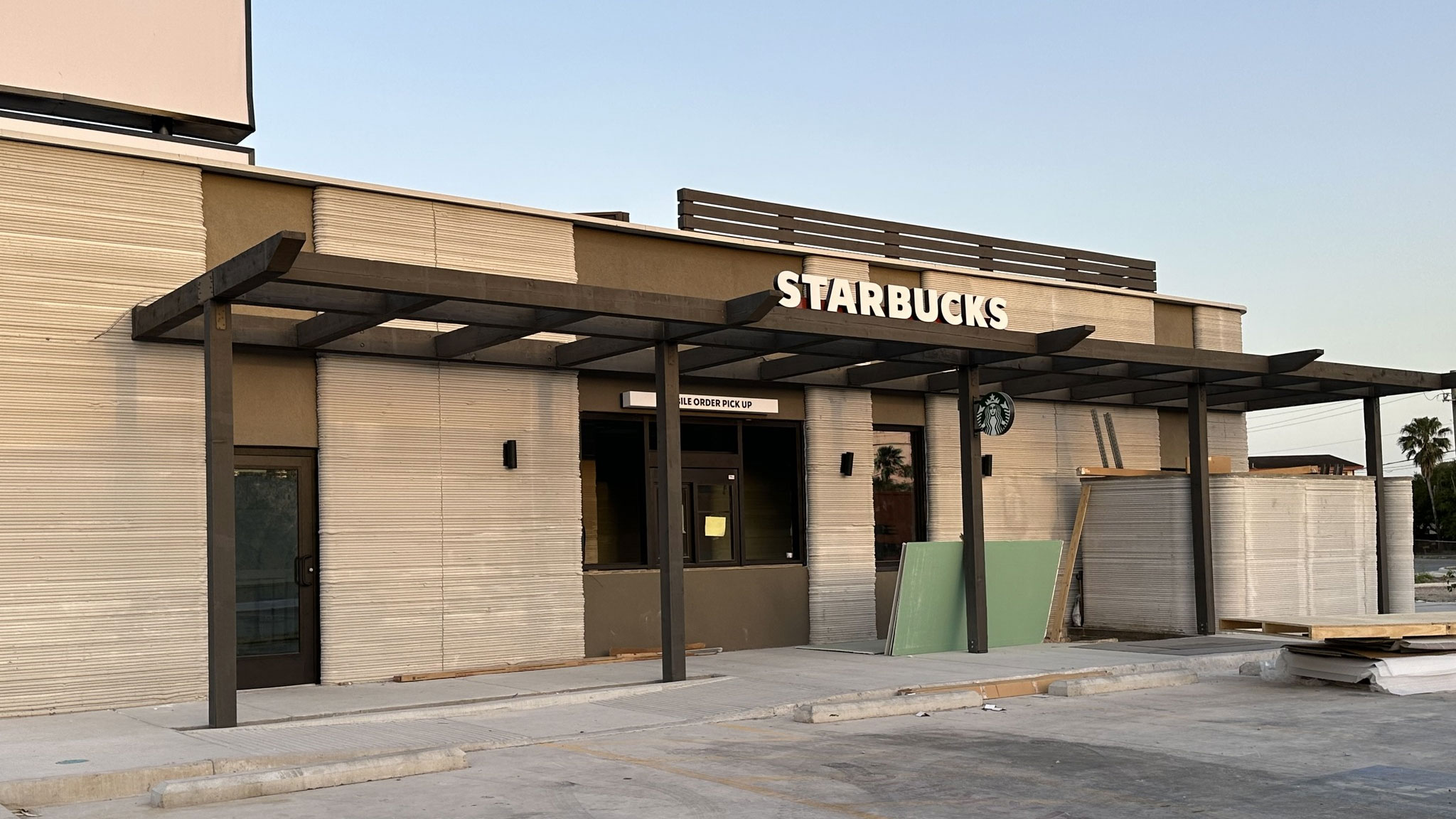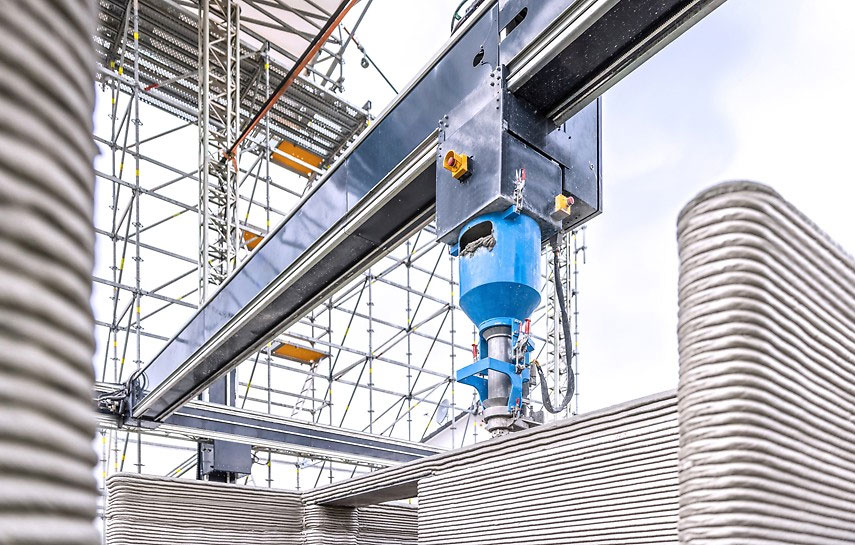First 3D-printed Starbucks coffee shop opens tomorrow in Texas
The 1,400 sq ft drive-through opens on April 28 in Brownsville.

The first 3D-printed Starbucks in the U.S. is opening in Brownsville, Texas. From tomorrow, the new Cobod BOD2 printed concrete fabricated Starbucks will be open for both in-person pickup and drive-through orders. Germany's Peri 3D Construction is behind the building project, which began late 2024.

3D printing technology for construction projects is some distance from our usual coverage of the hardware used to realize 3D digital files in the real-world. Unlike the best 3D printers we have looked at, the Peri 3D Construction BOD2's output material is similar to cement, rather than a plastic. Construction 3D printing is also done at a very large scale, and in this case, by a robot.
The new 3D-printed Starbucks in Brownsville isn't going to be a very large store, relatively speaking. In fact, its 1,400 sq ft shell is just enough for a mobile order pick up desk and drive-through coffee shop – no indoor seating. It would seem from the signage that there is no in-person walk-in order system.

According to Cobod, there have been more than 50 BOD2 printers delivered worldwide in the last three years. So, don't be surprised if you see this style of construction in a location near to where you live. As well as commercial premises, these devices are in use by house builders, smart buildings suppliers, academic institutions, and material manufacturers worldwide.
Printing at these larger scales also seems to lack the refinement offered by the best desktop style 3D printers you usually see reviewed on Tom's Hardware. You don't have to look very closely at the photos of the new Starbucks to see significant stepping in the finish. It looks like the material continues to flow a little, sometime after being applied, layer-by-layer. There are also highly visible misalignments and joins in parts of the building.
Some of the previous larger scale 3D printing projects we have reported on include coverage of the largest consumer 3D printer currently on the market – with an 800 x 800 x 1000mm build volume. Also, we enjoyed reporting on a YouTuber DIYing a 3D printer with a build volume of 1110 x 1110 x 2005mm just to make a life-size 3D model of himself...
Follow Tom's Hardware on Google News to get our up-to-date news, analysis, and reviews in your feeds. Make sure to click the Follow button.
Get Tom's Hardware's best news and in-depth reviews, straight to your inbox.

Mark Tyson is a news editor at Tom's Hardware. He enjoys covering the full breadth of PC tech; from business and semiconductor design to products approaching the edge of reason.
-
Alvar "Miles" Udell Sounds good until the first earthquake hits and it turns into a pile of rubble on top of you, because I don't see any reinforcement steel skeleton in the photos. Also they could have easily parged over the printed LavaCrete for a uniform look, but that would have cost money and time.Reply -
bit_user Reply
Is that a geologically unstable region?Alvar Miles Udell said:Sounds good until the first earthquake hits and it turns into a pile of rubble on top of you,
The curved corners would seem to confer some strength. I wonder how much they can vary the composition of the material to imbue it with some flexibility and tensile strength.Alvar Miles Udell said:because I don't see any reinforcement steel skeleton in the photos. -
bill001g I would be more hurricanes but it is a few miles inland so no storm surge just wind and I suspect that building can withstand even the largest hurricaneReply -
USAFRet Reply
Remains to be tested.bill001g said:and I suspect that building can withstand even the largest hurricane -
Alvar "Miles" Udell Replybit_user said:Is that a geologically unstable region?
The curved corners would seem to confer some strength. I wonder how much they can vary the composition of the material to imbue it with some flexibility and tensile strength.
There have been at least 25 earthquakes of magnitude 3 or higher in Texas this year so far, so while not on California level of activity it is higher than most states.
Assuming they are using LavaCrete, which seems to be the 3D printed material of choice, there's likely much more shock absorbency than in traditional concrete, but without a reinforcement of some sort I'd be afraid that it would collapse like a house of cards should one section fail, since looking at the building video on their (the construction company's) Instagram page, shell pieces are not joined together, but separate pieces where the windows and doors split them.
I'm sure there are ties in the ceiling that hold it all together somewhat, but to me it looks like there's a design fault in the name of cost savings. -
Notton I've seen videos of these printers in action. The workers insert rebar into the walls.Reply
example: https://www.sq4d.com/how-long-do-3d-printed-houses-last/No, IDK how they weld those bars in placewhen the printer is running.
Honestly, it looks about 50% better than the painted stucco new construction houses that somehow pass city inspection in AZ or TX. It has this 20 years weathered look, compared to a renovation from the 80's.
I'm guessing they have to actually inspect everything since it's an experimental building. -
Geef I'd be more concerned with the permanency of the walls. You want to put a new outlet in that room? That hole is there forever, you can't just replace the piece of drywall. It might also screw with stability of the entire wall. No wood studs or supporting structure.Reply
(kidding) Anyway we don't need to worry about losses in an Earthquake at a Starbucks. It's just a bunch of stuck up people who hang out there! :p -
usertests Reply
The next Einstein could be working inside that Texas Starbucks, how dare you.Geef said:(kidding) Anyway we don't need to worry about losses in an Earthquake at a Starbucks. It's just a bunch of stuck up people who hang out there! :p -
bit_user Reply
I'd expect wiring conduit and outlet panels are built into the walls, which would make upgrades & replacement a fairly easy affair.Geef said:I'd be more concerned with the permanency of the walls. You want to put a new outlet in that room? That hole is there forever, you can't just replace the piece of drywall. It might also screw with stability of the entire wall. No wood studs or supporting structure.
Also, I don't see why it should be that much different than a brick house. Just because you have brick on the outside doesn't mean you can't have drywall on the inside.